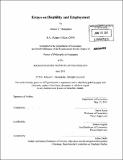| dc.contributor.advisor | David Autor and Joshua Angrist. | en_US |
| dc.contributor.author | Thompkins, Allison V. (Allison Victoria) | en_US |
| dc.contributor.other | Massachusetts Institute of Technology. Dept. of Economics. | en_US |
| dc.date.accessioned | 2011-08-30T15:42:13Z | |
| dc.date.available | 2011-08-30T15:42:13Z | |
| dc.date.copyright | 2011 | en_US |
| dc.date.issued | 2011 | en_US |
| dc.identifier.uri | http://hdl.handle.net/1721.1/65495 | |
| dc.description | Thesis (Ph. D.)--Massachusetts Institute of Technology, Dept. of Economics, 2011. | en_US |
| dc.description | Cataloged from PDF version of thesis. | en_US |
| dc.description | Includes bibliographical references. | en_US |
| dc.description.abstract | This dissertation consists of three essays which examine the impact of public policy on labor market outcomes of those with disabilities. The first essay analyzes a microlending program for people with disabilities in India. People with disabilities are disproportionately represented among the poorest of the poor in developing countries. An increasingly common method of combating poverty in developing countries, providing microlending through self help groups, has been largely unavailable to the disabled. This essay reports on one of the first programs in India to provide people with disabilities access to self help groups and microlending. Between 2002 and 2004, the Indira Kranthi Patham program began over 23,000 self help groups for people with disabilities in rural Andhra Pradesh. I evaluate the effect of this program on borrowing, education, labor market, and asset ownership outcomes by comparing people with disabilities to their non-disabled siblings in treatment and control villages. The estimates suggest that the program led to increased borrowing, education, and asset ownership, while having negative to zero impact on labor market participation among the disabled. The second essay evaluates the labor market effects of the American with Disabilities Act. In 1990, Congress passed the Americans with Disabilities Act(ADA) to improve the labor market opportunities of the disabled. Immediately following the enactment of the ADA, the employment rate of people with disabilities declined. However, the longer term labor market consequences of the ADA have not been studied. Interest in the longer term post-ADA employment trends of people with disabilities derives from the weakening of the ADA's employment provisions by the Supreme Court. The weakening of these provisions has decreased the cost to employers of hiring disabled workers. This essay uses variation in state disability laws and data from twenty years of the March Current Population Survey to determine the short and longer term impact of the ADA on labor market outcomes of people with disabilities. The estimates suggest that the ADA led to a short-term decline in weeks worked and labor force participation of those with disabilities while having an insignificant impact on these outcomes in the medium and longer run. The final essay explores the wage implications of the American with Disabilities Act for those with disabilities. Those with disabilities have persistently lower wages than the non-disabled. To improve labor market outcomes of the disabled, Congress passed the Americans with Disabilities Act (ADA). Immediately following the enactment of the ADA, the wages of people with disabilities decreased. However, the longer term wage consequences of the ADA have not been studied. Interest in longer term post-ADA wage trends of people with disabilities derives from the weakening of the ADA's employment provisions by the Supreme Court. This essay uses variation in state disability laws and data from twenty years of the March Current Population Survey to determine the short and longer term impact of the ADA on the log weekly wages of people with disabilities. Using data from the March Current Population Survey, this essay shows that the ADA led to a longer term increase in the weekly wages of those with disabilities. This finding is sensitive to the composition of the sample. Furthermore, this essay presents evidence that the wage effect of the ADA varies according to level of education. | en_US |
| dc.description.statementofresponsibility | by Allison V. Thompkins. | en_US |
| dc.format.extent | 136 p. | en_US |
| dc.language.iso | eng | en_US |
| dc.publisher | Massachusetts Institute of Technology | en_US |
| dc.rights | M.I.T. theses are protected by
copyright. They may be viewed from this source for any purpose, but
reproduction or distribution in any format is prohibited without written
permission. See provided URL for inquiries about permission. | en_US |
| dc.rights.uri | http://dspace.mit.edu/handle/1721.1/7582 | en_US |
| dc.subject | Economics. | en_US |
| dc.title | Essays on disability and employment | en_US |
| dc.type | Thesis | en_US |
| dc.description.degree | Ph.D. | en_US |
| dc.contributor.department | Massachusetts Institute of Technology. Department of Economics | |
| dc.identifier.oclc | 746659885 | en_US |
